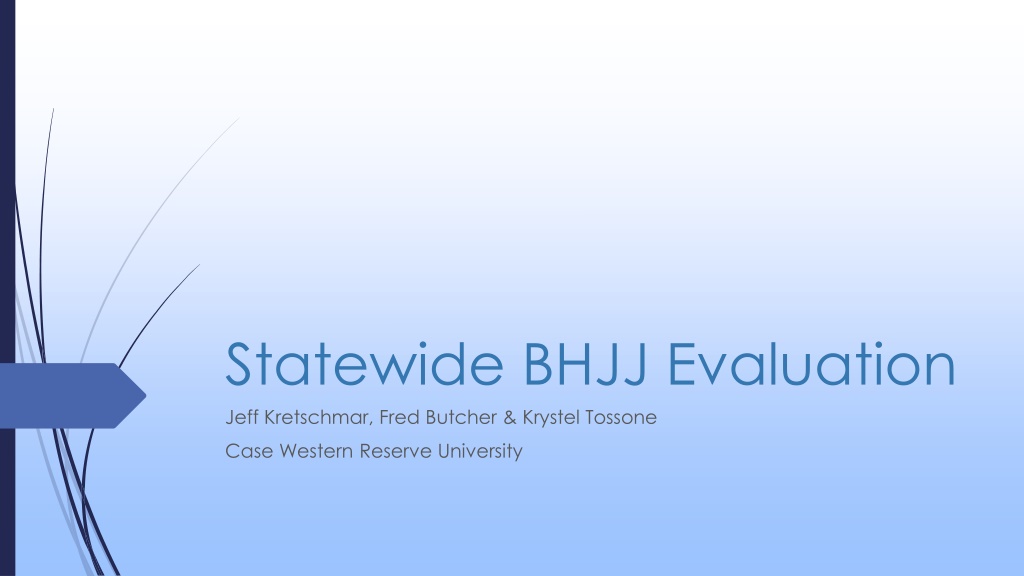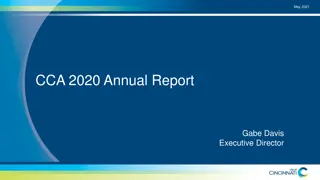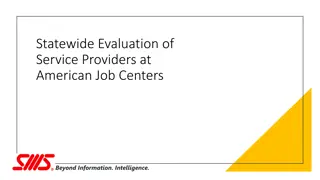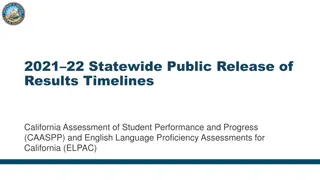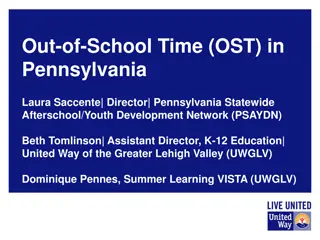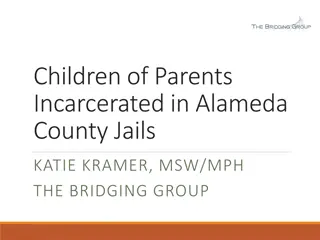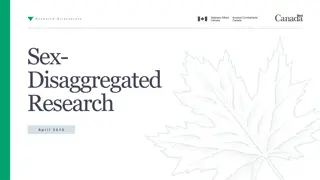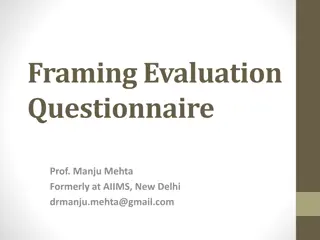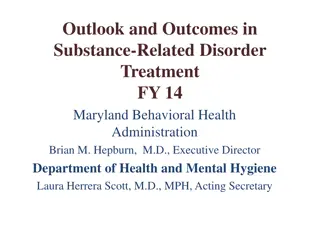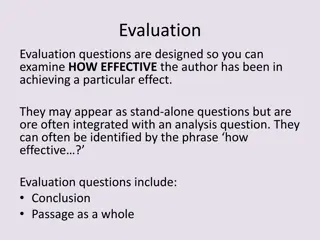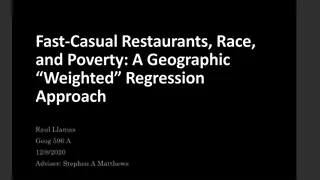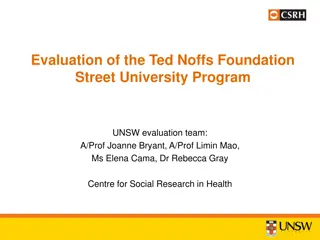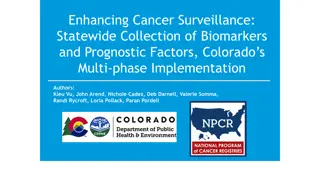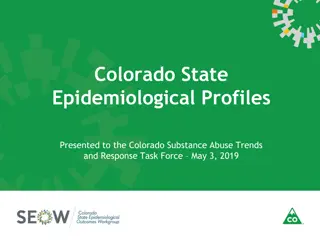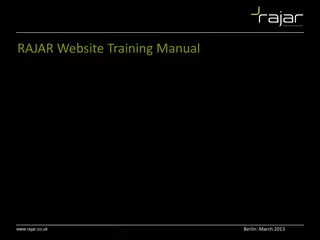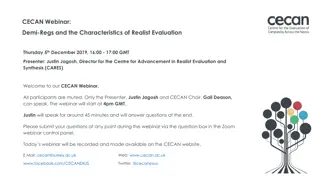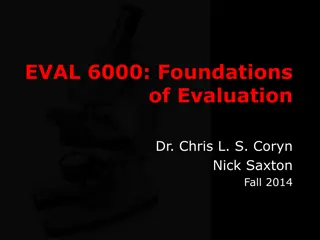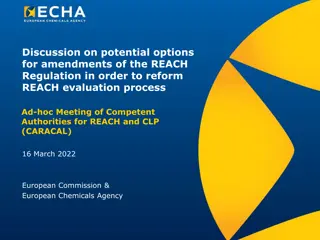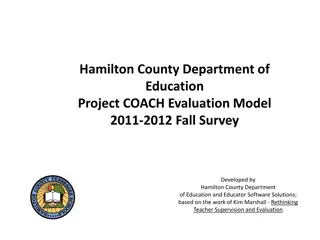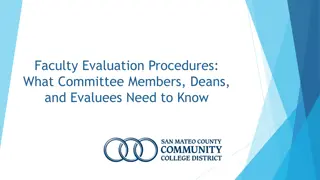Statewide BHJJ Evaluation Demographics and Trends Analysis
This report presents an evaluation of the Statewide BHJJ Program conducted by Jeff Kretschmar, Fred Butcher, and Krystel Tossone from Case Western Reserve University. It includes insights into youth demographics, enrollment numbers by county, felony trends, youth and family history, OYAS assessment at intake, and DSM diagnoses. Key findings reveal details about the enrolled youth, including gender distribution, race percentages, average age at intake, household income, caregiver education levels, and more. The analysis also highlights felony trends in specific counties over two different time periods, along with critical information on the youths' history and mental health assessments.
Download Presentation

Please find below an Image/Link to download the presentation.
The content on the website is provided AS IS for your information and personal use only. It may not be sold, licensed, or shared on other websites without obtaining consent from the author. Download presentation by click this link. If you encounter any issues during the download, it is possible that the publisher has removed the file from their server.
E N D
Presentation Transcript
Statewide BHJJ Evaluation Jeff Kretschmar, Fred Butcher & Krystel Tossone Case Western Reserve University
Demographics 4,349 youth enrolled since 2006 63% male 53% Non-white Average age at intake: 15.6 years 84% of youth lived with at least one biological parent at intake (60% mother) Over 80% of caregivers had a high school diploma or GED Average household income was between $15-20,000
Enrollment County Total Number of Youth Enrolled 25 453 546 326 25 101 255 35 1,761 288 47 25 4,349 Ashtabula Cuyahoga Franklin Hamilton Holmes Lorain Lucas Mahoning Montgomery Summit Trumbull Wayne Total
Felony Trends County Cuyahoga Franklin Hamilton Lucas Montgomery Summit Total 2013-2015 39.7% 78.8% 30.6% 70.5% 20.1% 92.4% 38.2% 2015-2017 55.0% 73.5% 42.6% 73.7% 15.1% 97.9% 35.3%
Youth and Family History Question Has the child ever been physically abused? Has the child ever been sexually abused? Has the child ever run away? Has the child ever had a problem with substance abuse, including alcohol and/or drugs? Has the child ever talked about committing suicide? Has the child ever attempted suicide? Has the child ever been exposed to domestic violence or spousal abuse, of which the child was not the direct target? Has anyone in the child s biological family ever been diagnosed with depression or shown signs of depression? Has anyone in the child s biological family had a mental illness, other than depression? Has the child ever lived in a household in which someone was convicted of a crime? Has anyone in the child s biological family had a drinking or drug problem? Females 18.3% ** 26.3% ** 58.1% ** 46.5% Males 13.6% 7.3% 45.0% 55.3% ** 49.3% ** 23.4% ** 39.9% 30.9% 10.0% 37.3% 67.8% ** 60.8% 49.3% ** 41.7% 38.6% 40.5% 60.8% * 56.2%
OYAS at Intake OYAS Low OYAS Moderate OYAS High Female 42.4% 40.9% 16.7% Male*** 28.4% 50.1% 21.4% White 40.0% 46.9% 13.2% Nonwhite*** 28.1% 47.9% 24.0%
DSM Diagnoses DSM-IV Axis I Diagnosis Alcohol-related Disorders Attention Deficit Hyperactivity Disorder Bipolar Disorder Cannabis-related Disorders Females 13.6% *** 27.3% Males 9.0% 45.9% *** 7.8% ** 31.7% 5.4% 41.5% *** 11.4% 30.9% *** 14.1% ** 43.2% 10.3% *** 22.3% *** 17.0% 11.1% 42.4% 5.2% Conduct Disorder Depressive Disorders Mood Disorder Oppositional Defiant Disorder Post-traumatic Stress Disorder 35% of females and 44% of males had a co-occurring substance use and mental health diagnosis.
Education Unsuccessful Completers Successful Completers Typical Grades Mostly A s and B s Mostly B s and C s Mostly C s and D s Mostly D s and F s Frequency at Intake Frequency at Termination Frequency at Intake Frequency at Termination 13.4% 16.5% 8.5% 21.0% 21.7% 24.6% 21.5% 38.0% 27.9% 25.8% 35.7% 27.5% 37.1% 33.0% 34.3% 13.5% At termination, workers reported that 62.1% of youth were attending school more than before starting treatment (27.0% were attending school about the same amount)
Ohio Scales: Problem Severity Problem Severity Scores from Intake to Termination 30 25 20 15 10 5 0 Intake Termination Youth Caregiver Worker *all comparisons from intake to termination are significant at the p < .001 level
Ohio Scales: Functioning Functioning Scores from Intake to Termination 70 60 50 40 30 20 10 0 Intake Termination Youth Caregiver Worker *all comparisons from intake to termination are significant at the p < .001 level
Trauma Symptoms Trauma Symptom Checklist for Children 10 9.3 9 7.5 8 7.2 7.1 7 6.3 5.8 5.6 6 4.8 Scores 4.6 5 3.9 3.7 4 3.1 3 2 1 0 Anxiety Anger Depression Dissociation PTS Sexual Concerns Intake Termination Statistically significant means observed from intake to termination for all subscales
TSCC and Gender TSCC Intake Scores by Gender 12 10.6 9.5 10 8.8 8.5 8.5 8 6.6 6.3 6.3 6 4.9 4.2 3.9 3.7 4 2 0 Anxiety Anger Depression Dissociation PTS Sexual Concerns Females Males
TSCC and Gender TSCC Termination Scores by Gender 9 8 8 7.2 6.7 6.6 7 6.3 6 5 5 5 5 3.6 4 3.2 3.1 3 3 2 1 0 Anxiety Anger Depression Dissociation PTS Sexual Concerns Females Males
TSCC and Gender Females at Termination vs Males at Intake 8.5 9 8 8 7.2 6.6 7 6.3 6.3 6.3 6 5 4.9 5 3.9 3.7 4 3.2 3 2 1 0 Anxiety Anger Depression Dissociation PTS Sexual Concerns Females - Termination Males - Intake
Violence and Trauma % Yes BHJJ Sample (n = 695) % Yes National Sample In the last year, did someone threaten to hurt you when you thought they might really do it? 14.4%a 37.3% In the last year, have you been hit or attacked because of your skin color, religion, or where your family comes from? Because of a physical problem you have? Or because someone said you were gay? 1.9%b 8.6% In the last year, did a boyfriend or girlfriend or anyone you went on a date with slap or hit you? 2.8% b 12.4% In the last year, did anyone steal anything from you and never give it back? Things like a backpack, money, watch, clothing, bike, stereo, or anything else? 16.6% a 48.6% In the last year, did anyone hit or attack you on purpose with an object or weapon? 5.7% a 16.0% 17.7% a In the last year, did anyone hit or attack you WITHOUT using an object or weapon? 38.4%
Violence and Trauma % Yes BHJJ Sample (n = 695) % Yes National Sample In the last year, did you get scared or feel really bad because kids were calling you names, saying mean things to you, or saying they didn't want you around? 21.8% a 26.4% In the last year, did a grown-up touch your private parts when they shouldn't have or make you touch their private parts? Or did a grown-up force you to have sex? 0.3% b 4.0% Now think about other kids, like from school, a boyfriend or girlfriend, or even a brother or sister. In the last year, did another child or teen make you do sexual things? 1.2% b 4.0% In the last year, did you SEE a parent get pushed, slapped, hit, punched, or beat up by another parent, or their boyfriend or girlfriend? 3.3% b 13.8% In the last year, in real life, did you SEE anyone get attacked on purpose WITH a stick, rock, gun, knife, or other thing that would hurt? 12.8% a 28.7%
Violence and Trauma % Yes BHJJ Sample (n = 695) % Yes National Sample In the last year, was anyone close to you murdered, like a friend, neighbor, or someone in your family? 5.4% a 24.1% In the last year, did you get scared or feel really bad because grown-ups in your life called you names, said mean things to you, or said they didn't want you? 9.7% a 29.6% Not including spanking on your bottom, did a grown-up in your life hit, beat, kick or physically hurt you in any way? 5.6% a 22.8% When someone is neglected, it means that the grown-ups in their life didn't take care of them the way they should. They might not get them enough food, take them to the doctor when they are sick, or make sure they have a safe place to stay. In the last year, were you neglected? 1.4% b 9.2%
Substance Use Males Females % Ever Used 60.5% 56.2% 14.8% *** 72.2% *** 5.0% 14.3% Age of First Use 13.3 12.7 13.6 13.1 14.7 14.1 % Ever Used 63.3% 57.0% 5.0% 64.4% 9.5% ** 17.2% * Age of First Use 13.4 12.7 13.9 13.3 14.6 14.1 Alcohol Cigarettes Chewing Tobacco Marijuana Cocaine Pain Killers (use inconsistent with prescription) Heroin Ritalin (use inconsistent with prescription) Barbiturates Non-prescription Drugs Hallucinogens Ecstasy Tranquilizers 2.8% *** 8.8% 1.0% 7.8% 14.9 13.2 14.6 13.9 1.5% 7.3% 14.4 14.2 2.4% * 8.5% 14.4 14.0 6.8% 5.5% 9.6% 14.6 14.7 14.5 6.0% 7.1% * 11.7% * 14.7 14.5 14.5
Substance Use Self-Report Previous 30 Day Substance Use from Intake to Termination for Males 100% 90% 80% 70% Percent Used 60% Alcohol Cigarettes Marijuana 50% 40% 30% 20% 10% 0% Intake Termination
Substance Use Self-Report Previous 30 Day Substance Use from Intake to Termination for Females 100% 90% 80% 70% Percent Used 60% Alcohol Cigarettes Marijuana 50% 40% 30% 20% 10% 0% Intake Termination
Termination Youth Enrolled from July 2015 to June 2017 Termination Reason All Youth Successfully Completed Services Client Did Not Return/Rejected Services 65.7% 63.7% 6.1% 4.3% 8.1% 2.7% 6.4% 3.0% 2.9% 5.2% 9.2% 2.4% 7.8% 2.6% 3.3% 6.8% Out of Home Placement Client/Family Moved Client Withdrawn Client AWOL Client Incarcerated Other
Termination The average length of stay for youth in the BHJJ program was 202 days. At intake, 56% of the youth were at risk for out of home placement. At termination, 25% of youth were at risk for out of home placement. Of those youth who successfully completed BHJJ treatment, 8% were at risk for out of home placement at termination while 58% of youth who terminated unsuccessfully from the program were at risk for out of home placement.
Termination Workers reported that police contacts has been reduced for 68.8% of the youth and had stayed the same for 22.9% of the youth. Police contacts increased for 6.1% of the youth and the worker was unable to estimate for 2.4.
Satisfaction with Services Satisfaction with BHJJ Services 71.1 26.1 Staff treated me with respect 62.7 32.8 Staff were sensitive to my cultural/ethnic background 39.5 52.1 I helped to choose my child's treatment goals 55.7 35.9 Overall I am satisfied with the services my child received 51.6 35.9 The services my child/family received were right for us 45.6 33.9 My family got the help we wanted for my child 0 10 20 30 40 50 60 70 80 90 100 Percent Strongly agree Agree
Recidivism After Termination Successfully Completed Treatment % of Youth Adjudicated Delinquent 23.7% % of Youth with Misdemeanors % of Youth with Felonies 27.9% 9.9% 6 months (N = 1,643) 12 months (N = 1,428) 47.8% 17.8% 39.7% Unsuccessfully Completed Treatment % of Youth Adjudicated Delinquent % of Youth with Misdemeanors % of Youth with Felonies 27.2% 13.2% 25.6% 6 months (N = 885) 12 months (N = 774) 45.6% 23.9% 41.9%
Recidivism We examined data for those youth who committed felony offenses in the 12 months prior to their BHJJ enrollment to determine if they had new felony charges after their BHJJ termination. Of the 847 youth who entered BHJJ with a felony, 32% were charged with a new felony in the 12 months after their termination from BHJJ. (27% of successful completers, 36% of unsuccessful completers) 142 BHJJ youth (3.9%) were committed to an ODYS facility at any time following their enrollment.
ODYS Commitments BHJJ County Youth Committed to ODYS after BHJJ Enrollment 21 (4.8%) 33 (6.4%) 18 (6.0%) 17 (7.7%) 21 (1.2%) 28 (10.5%) 142 (3.9%) Number of Youth in Recidivism Analysis 435 519 298 220 1,700 267 3,679 Cuyahoga Franklin Hamilton Lucas Montgomery Summit Total
OYAS at Intake and Outcomes OYAS Low OYAS Moderate OYAS High Felony Charge at 12 months*** 17.1% 29.5% 37.7% Delinquent Adjudications at 12 months*** Successful Completers*** 41.4% 54.5% 61.7% 76.2% 66.9% 55.5%
